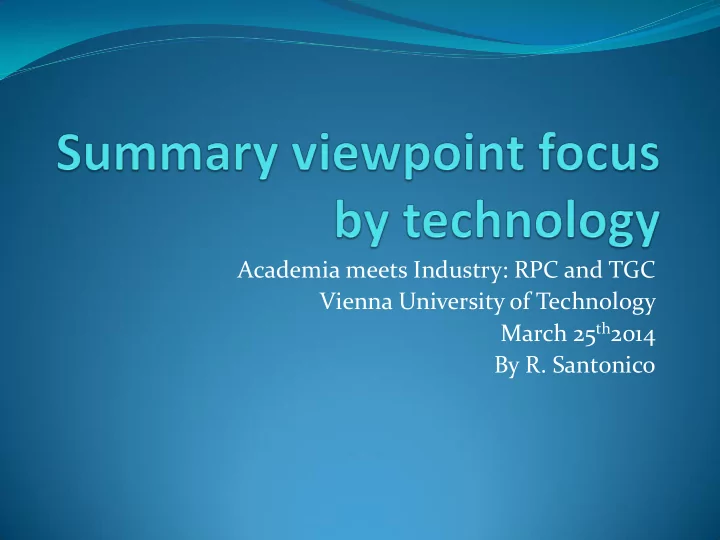

Academia meets Industry: RPC and TGC Vienna University of Technology March 25 th 2014 By R. Santonico
Industrial availability of materials Such large area detectors demand large amounts of qualified materials to be found in the industry Resistive electrodes require a material of good mechanical properties with resistivity around 10^10 - 10^12 Ohm cm. There is (there was) no industrial material qualified with this resistivity We tried therefore to qualify ourselves two industrial materials with resistivity approximately in the correct range: phenolic high Pressure Laminates and Glass It took a long work to adapt the standard production to our specific needs Thanks to the joint effort of research and industry the production of phenolic laminates and glass plates with the required resistivity it is now possible
Industrial availability of materials: the working gas The working gas A suitable RPC gas has good quenching properties ie good UV photon absorption and is somewhat electronegative Moreover it has also to fulfill other requirements concerning the safety and the environment preservation: non flammability (in most cases); low environment impact good gas candidates were found fin the refrigeration industry Therefore the RPC gas evolution closely followed the refrigeration gases evolution. A few examples CF3Br was widely used, some time ago, both in the refrigeration and as a RPC gas component. Its industrial production was strongly limited, by the Kyoto convention, for its environment impact C2H2F4 substituted the previous one. More gentle environment impact: one halogen instead of two, some hydrogen not replaced by fluorine. GWP about 1500 The Tetrafluoropropene molecule, with structure CH2=CFCF3 and GWP=4, Is the new gas industrially produced to replace C2H2F4 This new gas, which is presently under test, is characterized by a double Carbon bond, C=C, that is an unprecedented feature for the RPC gas
Introduction Single PCB’s can be purchased with dimensions of 1.28X3.00m² that are flat to within 50 μ m, except at the edges. Using usual PCB print methods are not very reproducible to the precision one needs. One needs VERY PRECISE external references, in order to align each plane with the design accuracy. CNC machining provides the necessary accuracy. Combined the 2 technologies.
Development of low resistivity glass Different compositions and related Process: production procedures have been Components: studied, yielding a tunable bulk SiO2, Fe 2 O 3 , Na 2 O ,AL 2 O 3 ,… resistivity in the range of 10 10 – 10 11 Ωcm. Melting In the mass production, in order to produce reliable glasses with high quality, surface measurement has been taken as a key part of the quality control. This glass shows a large stability against Cooling electrical stress. Cutting Glass resistivity: ~10 10 cm Polishing
Development of low resistivity glass 32cm x 30cm 6 6
Method utilize to get the precision Use the inserts that are machined together with the strips to get the precision
Use a precision jig to transfer the precision across layers
BULK Micromegas production steps Read-out board with Cu strips and resistive strips Laminated Photoimageable coverlay SS Stretched mesh on metal frame Laminated Photoimageable Frame coverlay Exposure Development + cure 18
BULK Micromegas examples BULK Technology DUPONT PC 1025 coverlay BOPP Meshes Largest size produced: 1.5m x 0.6m Limited by equipment ILC DHCAL T2K 19
Requirements from the CR physics An adequate circuit for the analog read out
Conclusions A strong Academia-Industry connection/collaboration will be the key element to create a number convincing scientific an industrial projects in the next future Several ideas for applications to the scientific projects to be developed in a few years are already there These projects will be possible only with a considerable industrial investment BUT…any investment implies the assumption of a risk that can be minimized but not reduced to zero. How this risk is balanced inside the proposed collaboration? My answer: the scientists risk there time and credit; the industry risks some money
Recommend
More recommend